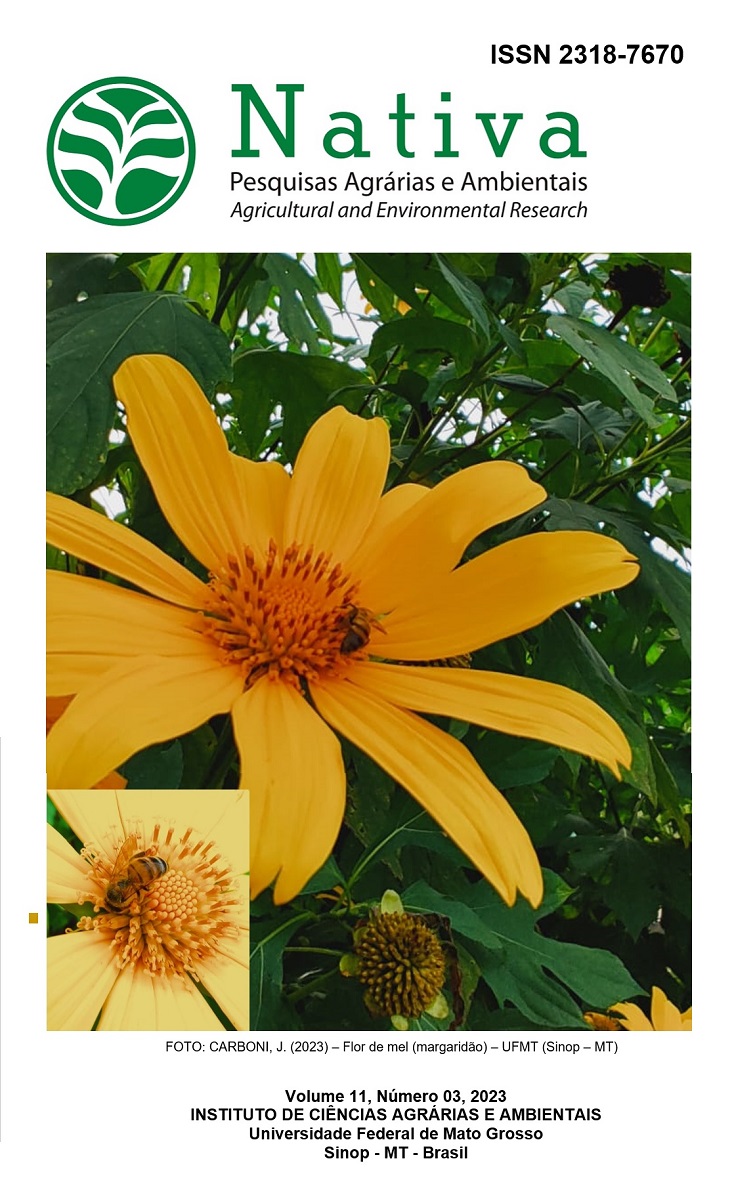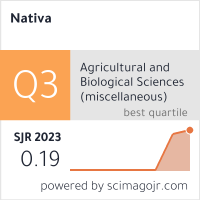NANOMATERIAL IN THE TREATMENT OF HEAVY METALS IN INDUSTRIAL WASTEWATER FROM THE NORTHERN REFINERIES COMPANY, IRAQ
DOI:
https://doi.org/10.31413/nat.v11i3.16001Palavras-chave:
attapulgite (NiCoFe2O4), copper (Cu), chromium (Cr), zinc (Zn), cadmium (Cd), lead (Pb)Resumo
In this study, a nanomaterial was synthesized from attapulgite clay to act as a new adsorption material. The synthesis of a compound (Attapulgite-NiCoFe2O4) was demonstrated within nanoscale measurements using X-ray Diffraction Measurements (XRD), Scanning Electron Microscopy (SEM), Surface Area Analysis, Vibrating Sample Magnetometer (VSM) and Transmission Electron Microscopy (TEM). Batch operations were carried out to study each of the effects of acidity, contact time, adsorbent dose, and ion concentration. The ideal values for the adsorption of lead were: pH (7), contact time (30) minutes, weight of the adsorption material (200 mg/L) and ion concentration (0.2 mg/L). The adsorption rate of lead was (88%).
Keywords: attapulgite (NiCoFe2O4); copper (Cu); chromium (Cr); zinc (Zn); cadmium (Cd); lead (Pb).
Nanomaterial no tratamento de metais pesados em águas residuais industriais da Companhia de Refinarias do Norte, Iraque
RESUMO: Neste estudo, um nanomaterial foi sintetizado a partir da argila attapulgita para atuar como um novo material adsorvente. A síntese de um composto (Attapulgite-NiCoFe2O4) foi demonstrada em nanoescala por meio de medições de difração de raios X (XRD), microscopia eletrônica de varredura (SEM), análise de área superficial, magnetômetro de amostra vibrante (VSM) e microscopia eletrônica de transmissão (TEM). Operações em lote foram realizadas para estudar o efeito da acidez, tempo de contato, dose do adsorvente e concentração de íons. Os valores ideais para a adsorção de chumbo foram: pH (7), tempo de contato (30) minutos, peso do material de adsorção (200 mg/L) e concentração de íons (0,2 mg/L). A taxa de adsorção de chumbo foi de (88%).
Palavras-chave: attapulgite (NiCoFe2O4), cobre (Cu); cromo (Cr); zinco (Zn); cadmium (Cd); prata (Pb).
Referências
Abdulkareem, M.A.; Joudi, M.S.; Ali, A.H. Eco-friendly synthesis of low-cost antibacterial agent (brown attapulgite-Ag nanocomposite) for environmental application. Chemical Data Collections. 2022;37:100814.
Al Kaabi, F.S.; Abdulkareem, M.A.; and Muhsin, N.A. Cost effective and low temperature method for the synthesis of MgTiO3 nanoparticles from natural dolomite. Materials Letters. 2022;320:132314.
Ali, N.S.; and Salem, C. Soil chemistry. Department of Soil Sciences and Water Resources. College of Agriculture, University of Baghdad. 2012;Dar Al-Kutub Al-Ilmiya Press, Al-Mutanabi Street, Baghdad- Iraq. (Translated book Sposito, 2008).
Allawi, A.H.; Alheety, M,A.; and Mohammed, M.Y. Ultrasound assisted synthesis of attapulgite-PdO nanocomposite using palladium complex for hydrogen storage. Kinetic studies. Inorganic Chemistry Communications. 2022;143:109787.
Allawi, A.H.; Mohammed, M.Y.; Ayrim, N.B.; Alheety, M.A.; and Mahmood, A.R. Synthesis of attapulgite-MnO2 nanocomposite from manganese complex by ultrasound for hydrogen storage. Journal of the Indian Chemical Society. 2022;99(8):100596.
Amer, M.W.; Khalili, F.I.; Awwad, A.M. Adsorption of lead, zinc and cadmium ions on polyphosphate-modified kaolinite clay. 2010.
Blanco, A. The impact of solid and liquid wastes from a rural town on the Chorobamba River Oxapampa, Peruvian Amazon. 2005.
Durand, J. The impact of gold mining on the Witwatersrand on the rivers and karst system of Gauteng and North West Province, South Africa. Journal of African Earth Sciences. 2012;68:24-43.
Hussein, Maha Hamdei, and Ibrahim Omar Saeed. 2022. “Phytoremedation: Plant Synergy - Bacteria for Treatment of Heavy Metals.” Journal of Pharmaceutical Negative Results 13:933–41. doi: 10.47750/pnr.2022.13.S01.111.
Kim, J.; and Benjamin, M.M. Modeling a novel ion exchange process for arsenic and nitrate removal. Water research. 2004;38(8):2053-62.
Kumar, P.R.; Chaudhari, S.; Khilar, K.C.; and Mahajan, S.P. Removal of arsenic from water by electrocoagulation. Chemosphere. 2004;55(9):1245-52.
Ning, R.Y. Arsenic removal by reverse osmosis. Desalination. 2002;143(3):237-41.
Porter, M.C. Handbook of industrial membrane technology. 1989.
Shit, S.H.M. A study of the factors affecting the adsorption of ions of some heavy metals on an Iraqi clay. Master Thesis. 2008;College of Education - University of Mosul.
Tuutijarvi, T.; Lu, J.; Sillanpää, M.; and Chen, G. A (V) adsorption on maghemite nanoparticles. Journal of hazardous materials. 2009;166(2-3):1415-20.
Uddin, M.K. A review on the adsorption of heavy metals by clay minerals, with special focus on the past decade. Chemical Engineering Journal. 2017;308:438-62.
Zeng, S.; Gong, X.; Han, X.; Xu, S.; Xu, J.; and Li, X. Effect of organic attapulgite on properties of SBS modified asphalt waterproofing membranes. Construction and Building Materials. 2022;360:129606.
Downloads
Publicado
Edição
Seção
Como Citar
Licença
Copyright (c) 2023 Nativa

Este trabalho está licenciado sob uma licença Creative Commons Attribution-NonCommercial 4.0 International License.
Direitos Autorais para artigos publicados nesta revista são do autor, com direitos de primeira publicação para a revista. Em virtude de a aparecerem nesta revista de acesso público, os artigos são de uso gratuito, com atribuições próprias, em aplicações educacionais e não-comerciais.
A artigos publicados nessa revista, podem ser reproduzidos parcialmente ou utilizados como referência por outros autores, desde que seja cita a fonte, ou seja, a Revista Nativa.
Copyright for articles published in this journal are the authors, with first publication rights granted to the journal. The journal shows open access, and articles are free to use, with proper attribution, in educational and non-commercial.
The articles published in this journal may be reproduced in part or used as a reference by other authors, provided that the source is quoted.






